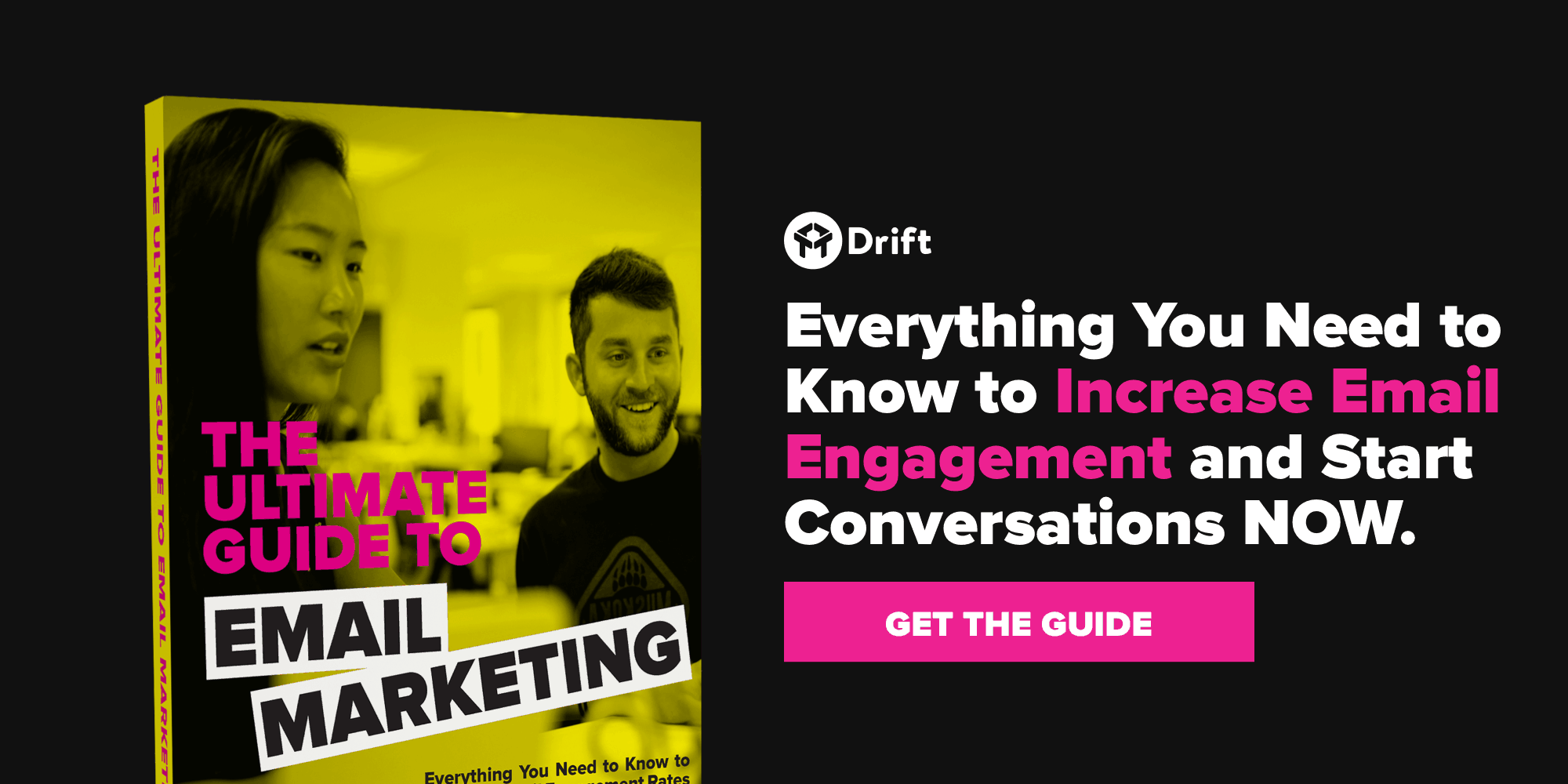
Embracing the sales email template doesn’t mean you’re cheating—you’re just efficient so you can reach out to more prospects in less time.
The time-saving benefits are a no-brainer, but what, exactly, makes a sales email template a winner?
The short answer is, it shouldn’t feel like a template. Ideally, you want to create a template that you can easily personalize to better relate to the recipient.
Nobody wants to receive an email they can tell was copied and pasted over and over–it feels irrelevant, regardless of whether or not there’s an amazing offer on the table.
In this article, we’ll take a look at some email template examples that you can personalize in a matter of seconds. Let’s dive in.
What is the Goal of Your Email?
Ultimately, the goal of any email is to get a response. But, beyond the obvious, what do you want your prospect to do next? Book a meeting? Chat with a rep? Upgrade before the free trial ends? Whatever it is, be clear about what you want this person to do next.
Make it Personal
The template should function as a framework that does the bulk of the heavy lifting. Again, that doesn’t mean it should be a cookie-cutter. Instead, the perfect sales email template should take care of the formatting, be centered around a specific next step, and use the same strategy.
This means, when it’s time to send the message, you’ll swap out a few personal tidbits that seal the deal. Templates are similar to automation—they’re a tool that helps you save some time so that you can focus on the parts of your message that connect with recipients.
This is especially important in cases where you’re trying to reconnect with a prospect or prove that you understand their situation. Here are a few areas where personalization goes a long way:
- Use specific names of people, products, and companies.
- Mention the company’s mission, a person’s role, and any associated accomplishments or industry news.
- Address specific challenges and pain points, along with how your company is uniquely qualified to help.
- Reference notes from past conversations.
Flatter Them
According to Forbes, research shows that people love a good compliment almost as much as they love cold, hard cash. Don’t be a suck-up, people can see right through the BS. Instead, mention a piece of content that you genuinely liked or congratulate the prospect on a recent promotion or accolade.
Be Helpful
To do this, you should have content prepared for every persona and every stage in the buyer’s journey. This allows you to prove that you’re more about solving problems than pushing a sale through as quickly as possible.
We recommend making a content calendar of sorts with a list of recommended reading for each pain point, challenge, or potential objection by phase and by persona. This can be a mix of your own content—blog posts, knowledgebase articles, or favorites from other creators from around the web. We’re not saying you should
Sales Pitch Template Ideas
If the purpose of your email is to pitch your prospect, the first thing you’ll want to think about is whether you’ve made contact with this person in the past or if this is the first attempt to get in touch.
Here’s an example from Sales Hacker that references a past conversation:
“Hi Sarah,
Thank you for taking some time to speak with me over coffee at Dreamforce on Tuesday. Loved your booth design!
When you mentioned that you sometimes feel like you’re sending your proposals into a black hole, it struck a chord with me. I had that problem at my previous company, too.
Now at DocSend, I help other media companies – like Mic, for example – solve that problem, by giving them insight into who engages with the document and when.
I think I can help you prioritize deals that show more engagement. Can we talk about it next week sometime?
Lisa”
This example is effective, because it dives right into being helpful. The sender recalls specific details about the prospect, making it sound like she’s been considering some ways she might help solve these problems.
Look at your CRM and refer back to past conversations. You might recall that you chatted about a mutual interest or a big change in the industry. Whatever the link, the point is to show the prospect you remember talking to them and that you have some ideas about dealing with their problem.
This technique can be used whether you met someone in person, connected on LinkedIn, or spoke on the phone in the past. That said, the real power comes from having asked some discovery questions in the past.
Additionally, you can also apply this method if you’ve collected information about leads through your site’s chatbot.
Consider building in the following questions and presenting them to qualified leads:
- What challenges do you face?
- How are you dealing with that challenge now?
- How are you measuring success?
Another example is this one from Ryan Robinson. It works because Robinson starts out by complimenting the recipient, then provides a resource the prospect might be interested in. Finally, he closes by casually asking if the prospect wants to chat.
Here’s another way to approach the pitch, similar to the Ryan Robinson example. What we’ve done instead is connected the email to real-time messaging. So, if Chelsea visits the website, she’ll get a message that directly relates to the email content.

Finding a Decision-Maker Template
If you’re cold pitching, you want to be sure your email lands in the correct inbox. The idea here is, people generally like being helpful. If Dan is on the lower end of the totem pole, he’s probably used to dealing with people trying to get to the boss. So, be respectful and approach him like you’re asking for a favor.
Hi Dan,
I’m trying to find out who the best possible person would be to discuss [pain point, common industry problem] at your company.
Would you mind pointing me toward the right person and the best way to reach them?
Thank you in advance for your help.
Regards,
Jane Doe
If successful, this email template may result in a semi-referral. For example, if you lead with “Jesse in Marketing recommended reaching out to you to discuss [pain point]” the conversation inherently kicks off on a warmer note.
Cold Sales Email Template
This cold email template is a winner because it focuses primarily on being helpful.
![]()
So why does this one work? There are a few things working here.
- It Addresses Pain Points—Though this is a cold email, the sender highlights a common issue that marketers have: where should they allocate the budget? How can they get the most out of their lead database?
- It’s Helpful—Promotes blog content relevant to the recipient’s role while aiming to answer questions and solve pain points, proving that this company is knowledgeable.
- Opens Up Communication—In this example, the rep gives the recipient the option to set up a call. You might approach this by sending a link to a calendar or follow this example and email the old-fashioned way. Another idea is adding a link to chat directly if the prospect has questions.
Referral Email Template
This cold email template is an effective way to reach out when you’re not sure who you should be reaching out to. Ideally, you’re at least reaching out to the right department and not to someone in accounting when your target is the marketing director, otherwise, your email might get tossed in the trash.
By adding the names of a couple of clients you work with, there’s a dash of social proof in the email, that helps build trust with whoever gets the message.
Hey [First Name],
[Your Name] from Drift here. Hope you don’t mind me reaching out 🙂
We help businesses like [Client 1] and [Client 2] to grow their website conversation volume and sales pipeline.
I’m curious who might be best to speak with about conversational marketing at your company?
Cheers,
[Your Name]
The Follow-Up Email Template
Statistics are all over the place on this one, but experts agree, it takes anywhere between 5 and 13 attempts to close a sale. The number doesn’t matter so much, the point is, follow-ups should be a priority because persistence pays off.
One way to approach the follow-up is by using the classic “three options” format. The reason this is a tried and true template is, you’ve turned the email into a multiple-choice question, making it super easy for the prospect to respond.
Hi {{Name}},
I see you’re too busy to reply at the moment. Could you please just hit me back with a number 1-2-3 that best describes your response?
Please leave me alone!
Too busy, email me again in a month, please.
I’ll write you back in a week.
Here’s another follow-up example sourced from our own nurture email template archives. Here, we lead with a casual subject line, “how long has it been,” which immediately fosters a sense of familiarity.

Follow-ups can come off as annoying. Here are a few things you can do to avoid irritating your prospects:
- Make Things Easy—Be as specific as possible with your CTAs and subject lines. People receive tons of emails and the last thing they want is to figure out what, exactly, you want them to do. Keep things short and tell prospects what to do next.
- Do NOT Mark Emails as High Priority—It doesn’t matter what you’re selling, there’s no way that this is an urgent matter. Some reps believe marking an email “high priority” is a good way to be seen in a crowded inbox. The effect, however, is it makes sales reps appear pushy and arrogant. Standing out means creating effective subject lines and bringing value to the recipient. The bottom line is don’t trick your prospects.
- Wait a Reasonable Amount of Time Before Following Up—It’s okay to follow up five, eight, or 13 times, but it’s more about timing than the final message count. Sending a follow-up email too soon tells prospects you don’t care about their time.
Wrapping Up
Email templates aren’t an excuse to copy and paste the same content over and over until someone signs a contract. Instead, they’re an essential tool that salespeople can use to save time (and pay more attention to honing their sales closing techniques). No need to worry about formatting or what kind of tone you’d like to strike.
That extra time allows you to personalize the parts that count or present an offer specific to each prospect. Focus on making things easy for your prospects and consider what factors might drive them to reply back.
For more ways to level up your email marketing savvy, download our Ultimate Guide to Email Marketing here. Inside you’ll find everything you need to know from nailing the timing to writing copy that converts.




